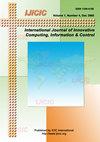无线传感器网络分布式CESVM-DR异常检测
IF 1.1
Q4 COMPUTER SCIENCE, ARTIFICIAL INTELLIGENCE
International Journal of Innovative Computing Information and Control
Pub Date : 2019-05-31
DOI:10.11113/IJIC.V9N1.218
引用次数: 1
摘要
如今,传感器技术的进步,引入了智能生活社区,传感器之间或与其他实体进行通信。这就引入了一个新术语——物联网(IoT)。从传感器节点收集的数据将在称为基站或接收器的端点进行分析,以进行决策。不幸的是,准确的数据通常并不准确和可靠,这将影响基站的决策。造成数据不准确、不可靠的原因有很多,如恶意攻击、恶劣环境、传感器节点本身故障等。更严重的情况下,节点故障还会导致整个网络的故障。因此,本文采用无监督单类支持向量机(OCSVM)来构建资源约束无线传感器网络(WSNs)中的异常检测方案。采用分布式网络拓扑结构,最大限度地减少网络中的数据通信,延长网络寿命。同时,降维为异常检测方案提供了轻量级。为了提高异常检测方案的高效性和有效性,本文提出了分布式中心超椭球支持向量机异常检测方案。本文章由计算机程序翻译,如有差异,请以英文原文为准。
Distributed CESVM-DR Anomaly Detection for Wireless Sensor Network
Nowadays, the advancement of the sensor technology, has introduced the smart living community where the sensor is communicating with each other or to other entities. This has introduced the new term called internet-of-things (IoT). The data collected from sensor nodes will be analyzed at the endpoint called based station or sink for decision making. Unfortunately, accurate data is not usually accurate and reliable which will affect the decision making at the base station. There are many reasons constituted to the inaccurate and unreliable data like the malicious attack, harsh environment as well as the sensor node failure itself. In a worse case scenario, the node failure will also lead to the dysfunctional of the entire network. Therefore, in this paper, an unsupervised one-class SVM (OCSVM) is used to build the anomaly detection schemes in recourse constraint Wireless Sensor Networks (WSNs). Distributed network topology will be used to minimize the data communication in the network which can prolong the network lifetime. Meanwhile, the dimension reduction has been providing the lightweight of the anomaly detection schemes. In this paper Distributed Centered Hyperellipsoidal Support Vector Machine (DCESVM-DR) anomaly detection schemes is proposed to provide the efficiency and effectiveness of the anomaly detection schemes.
求助全文
通过发布文献求助,成功后即可免费获取论文全文。
去求助
来源期刊
CiteScore
3.20
自引率
20.00%
发文量
0
审稿时长
4.3 months
期刊介绍:
The primary aim of the International Journal of Innovative Computing, Information and Control (IJICIC) is to publish high-quality papers of new developments and trends, novel techniques and approaches, innovative methodologies and technologies on the theory and applications of intelligent systems, information and control. The IJICIC is a peer-reviewed English language journal and is published bimonthly

 求助内容:
求助内容: 应助结果提醒方式:
应助结果提醒方式:


